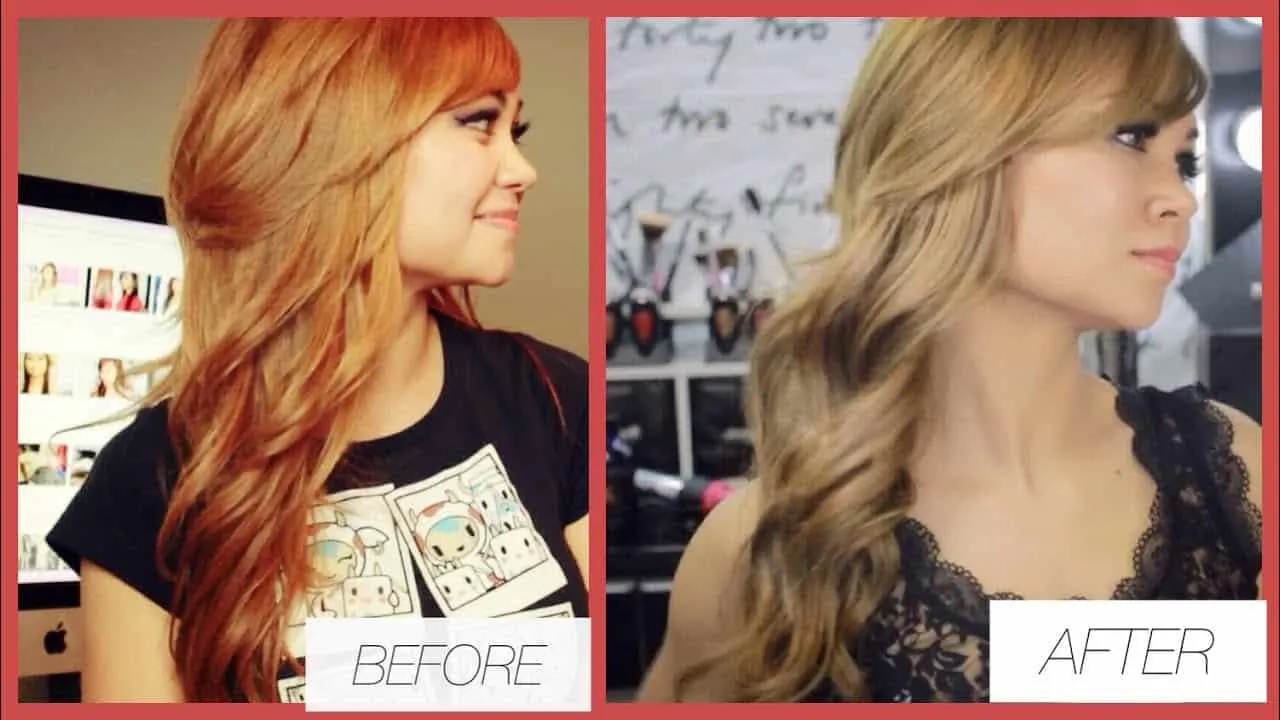If you enjoy experimenting with blonde or light hair colors, you might have already encountered a time or two where the results of a dye job didn’t work out quite the way you planned. Maybe your new hair color was a bit bland or lusterless, or perhaps, on the opposite end of the spectrum, it turned out to be too brassy or rusty. Toner for orange hair to the rescue!
What is Toner for Orange Hair?
A toner for orange hair is an auxiliary product, like a dye, that doesn’t bleach your hair or add color to it. Instead, it removes and “tones” down the hues that sometimes occur after the dyeing process, such as brassy yellows, oranges and reds. When properly used, a toner corrects these unwanted colors, so you end up with a more desirable cool and “ashy” result.
How Does Toner Work?

Toner for orange hair – before and after
Most permanent hair dyes or highlights use a combination of ammonia and hydrogen peroxide to create a chemical reaction that changes the color of your hair. The peroxide bleaches the natural color and releases oxygen to promote further chemical reactions, and the ammonia breaks down the outer cuticle of the hair shaft so the new color can penetrate it. After the process is finished, you are left with a “raw” hair shaft that is vulnerable to breakage, split ends, and, quite often, an unattractive tangerine color that looks cheap and unrefined.
A toner for orange hair resolves these problems because it acts as a protective topcoat (think manicure) on your hair shaft and leaves it shiny, smooth, and, most of all, not brassy.
Remember when you were a little kid in art class, and you learned that mixing two or more paint colors could create an entirely new color? Then, remember when you got a little older and learned in science class about the color spectrum and light refraction? Well, these same principles are the technical basis of how toner products work to neutralize brassy colors. For example, purple toners reduce orange brassiness on blonde hair and keep it looking fresher and more vibrant. Blue toner products work better on darker hair because they “cut” or “cancel out” the strong rust-colored tones.
How to Select a Toner
Like all hair color products, toners come in a variety of options. The type of product you choose may change, depending on whether you want to:
- Lighten things up
- Add a pastel hue
- Go from brassy to classy
As you make your decision, also keep in mind the following points:
- Strengths: Toners come in vols. 10, 20, 30 and 40 (salons frequently use vol. 20)
- Quality: You get what you pay for. Salon treatments are usually better than home treatments.
- Application Systems: Shampoos, Brush in, Squeeze Bottles
- Hair Tone Colors: Use a color wheel to determine the best shade that will neutralize your current color and enhance the tone you want.
Will Toner for Orange Hair Cause Damage?
Any product that alters the chemical composition of your hair will have an impact over time, but if you don’t overdo it, and if you give your hair periodic breaks between treatments, you should be OK. Also, to minimize the effects of chemical processing on your hair, be sure to get regular cuts and trims to remove damaged ends and discolored sections.
How to Apply Toner for Orange Hair

We recommend that you go to a qualified salon professional whenever you are doing a color treatment on your hair. Nevertheless, if you choose to apply it on your own, please follow these guidelines:
- After dyeing your hair, make sure it’s washed thoroughly and towel dried.
- Do a strand test first; your hairs’ porosity could vary the results, so it’s best to be sure.
- Apply the toner to the areas that need the most color correction first. If all the hair needs toning, then start at the roots and work your way down to the ends.
- Leave the toner in for 5-20 minutes. Rinse small strands every 3-5 minutes to check how the toner treatment is progressing.
Toners are multifunctional products that can provide a variety of benefits to your hair. Not only do they liven up and refresh your hair color, but they also strengthen your hair’s shaft by sealing it and creating a protective barrier against further damage. This sealing activity has the secondary effect of plumping up each hair shaft, so overall, your locks will appear fuller and more voluminous.
